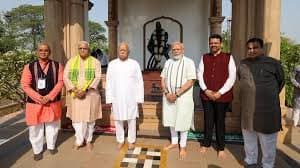
Predicting who will lead the Bharatiya Janata Party (BJP) after Narendra Modi is a topic steeped in speculation, as no official succession plan has been publicly confirmed by the party or its ideological parent, the Rashtriya Swayamsevak Sangh (RSS). The debate often flares up around key events, such as Modi’s visits to RSS headquarters or statements from political figures, but concrete evidence remains elusive.
The BJP’s leadership transition is influenced by its close ties with the RSS, which historically plays a significant role in shaping the party’s direction. Modi, now 74 (as of April 2025), has been a dominant figure since 2014, leading the party to major victories in 2014 and 2019, though the 2024 election saw the BJP lose its outright majority, relying on the National Democratic Alliance (NDA) to govern. This shift has fueled discussions about his long-term tenure, especially given the informal precedent of senior BJP leaders stepping back at 75—though Modi has not confirmed adhering to this.
Recent speculation intensified after Modi’s March 30, 2025, visit to Nagpur, where he paid tribute to RSS founder K.B. Hedgewar. Some, like Shiv Sena (UBT) leader Sanjay Raut, claimed this signaled the RSS would soon choose Modi’s successor, possibly from Maharashtra, with Modi resigning by September 2025. However, Maharashtra CM Devendra Fadnavis dismissed this, asserting Modi’s leadership extends to 2029. The RSS has not publicly endorsed any timeline or candidate, and Modi’s visit aligns with the organization’s centenary celebrations, not necessarily succession talks.
Potential contenders within the BJP include:
- Amit Shah: The powerful Home Minister and Modi’s close ally, known for strategic acumen, though his age (60 in 2025) and polarizing style might complicate broader appeal.
- Yogi Adityanath: Uttar Pradesh CM, a Hindutva hardliner with a strong base, but his aggressive approach could limit national consensus.
- Nitin Gadkari: Transport Minister and a senior leader with RSS roots, often cited as a moderate alternative, though he’s faced internal rivalry.
- Rajnath Singh: Defence Minister and a veteran, seen as a unifying figure, with some unverified claims suggesting his name was “frozen” during Modi’s Nagpur visit.
- Others: Names like Dharmendra Pradhan, Shivraj Singh Chouhan, or J.P. Nadda (current BJP president) also surface, depending on RSS and party dynamics.
The RSS’s influence is key, but its decisions are opaque, typically made behind closed doors. Past tensions—such as Nadda’s 2024 claim that the BJP operates independently of the RSS—suggest occasional friction, yet their interdependence endures. The BJP’s formal process for electing its president involves an electoral college of national and state council members, requiring a candidate with 15 years of active membership and support from multiple states. This could shape the next leader, but Modi’s outsized influence means any transition might hinge on his endorsement or exit.
As of now, the debate is speculative. Modi remains the BJP’s central figure, and no RSS meeting has definitively sparked a succession plan. The party’s performance in upcoming state elections (e.g., Maharashtra, Haryana) and Modi’s health and political will could ultimately dictate the timeline and choice. Without official statements, the question of who leads next remains open, driven more by political chatter than confirmed intent.





